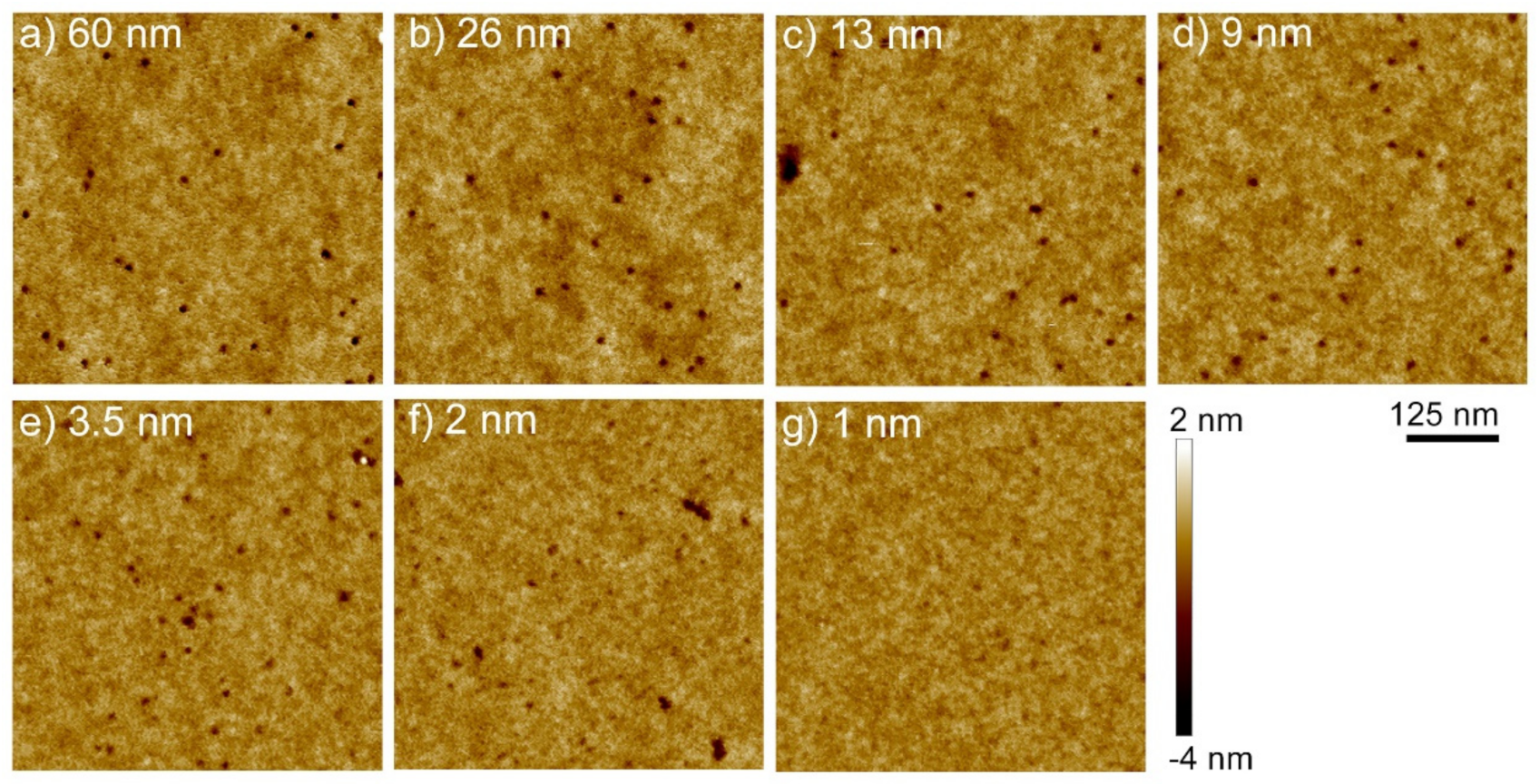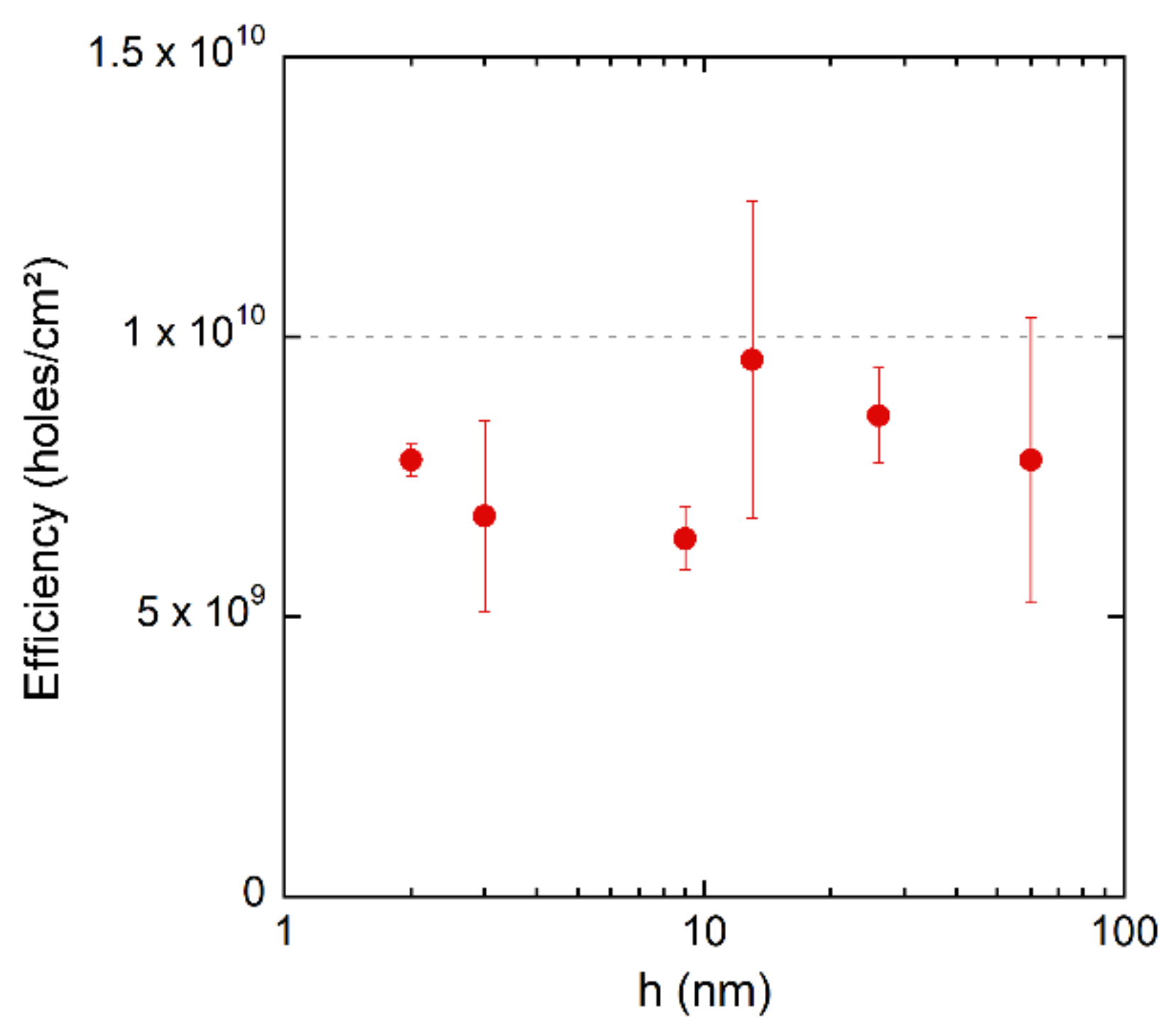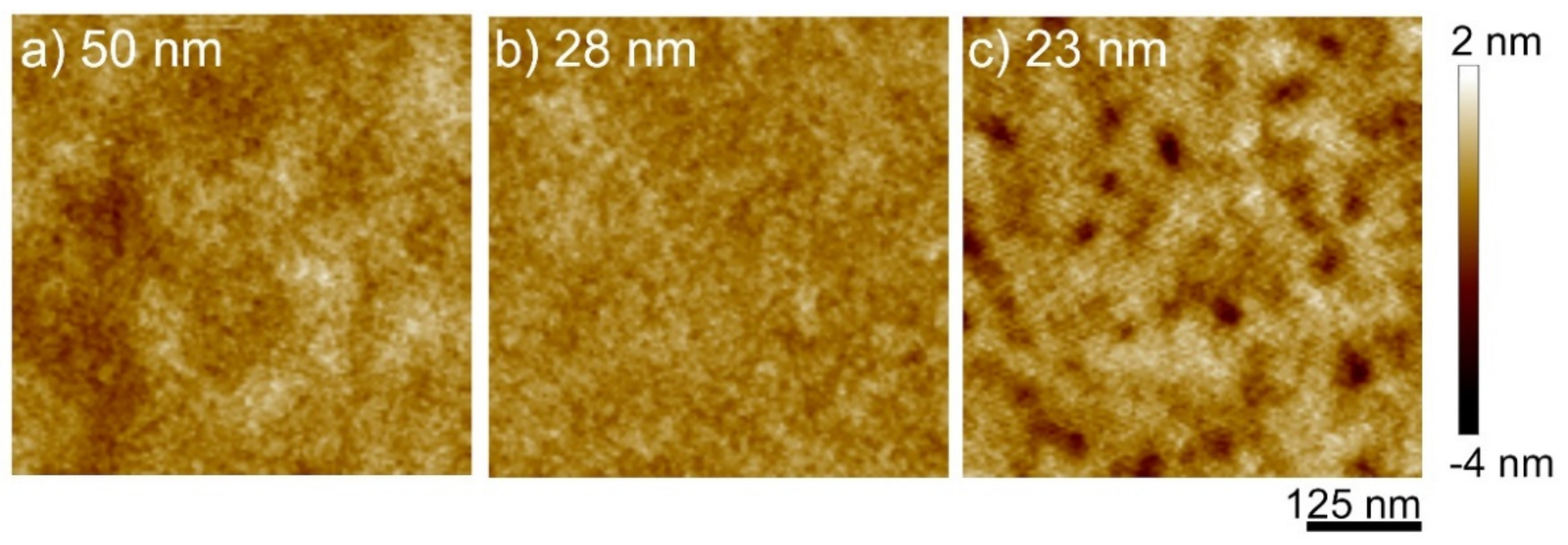Cratering Induced by Slow Highly Charged Ions on Ultrathin PMMA Films
Abstract
1. Introduction
2. Results
3. Discussion
4. Materials and Methods
5. Conclusions
Author Contributions
Funding
Institutional Review Board Statement
Informed Consent Statement
Data Availability Statement
Acknowledgments
Conflicts of Interest
References
- Donnelly, S.E.; Birtcher, R.C. Heavy ion cratering of gold. Phys. Rev. B 1997, 56, 13599–13602. [Google Scholar] [CrossRef]
- Birtcher, R.C.; Donnelly, S.E.; Schlutig, S. Nanoparticle ejection from Au induced by single Xe ion impacts. Phys. Rev. Lett. 2000, 85, 4968–4971. [Google Scholar] [CrossRef] [PubMed]
- Insepov, Z.; Manory, R.; Matsuo, J.; Yamada, I. Proposal for a hardness measurement technique without indentor by gas-cluster-beam bombardment. Phys. Rev. B 2000, 61, 8744–8752. [Google Scholar] [CrossRef]
- Thibaudau, F.; Cousty, J.; Balanzat, E.; Bouffard, S. Atomic-force-microscopy observations of tracks induced by swift kr ions in mica. Phys. Rev. Lett. 1991, 67, 1582–1585. [Google Scholar] [CrossRef]
- Kopniczky, J.; Reimann, C.T.; Hallen, A.; Sundqvist, B.U.R.; Tengvall, P.; Erlandsson, R. Scanning-force-microscopy study of MeV-atomic-ion-induced surface tracks in organic-crystals. Phys. Rev. B 1994, 49, 625–628. [Google Scholar] [CrossRef]
- Eriksson, J.; Rottler, J.; Reimann, C.T. Fast-ion-induced surface tracks in bioorganic films. Int. J. Mass Spectrom. 1998, 175, 293–308. [Google Scholar] [CrossRef]
- Neumann, R. Scanning probe microscopy of ion-irradiated materials. Nucl. Instrum. Methods Phys. Res. Sect. B-Beam Interact. Mater. At. 1999, 151, 42–55. [Google Scholar] [CrossRef]
- Papaleo, R.M.; Silva, M.R.; Leal, R.; Grande, P.L.; Roth, M.; Schattat, B.; Schiwietz, G. Direct Evidence for Projectile Charge-State Dependent Crater Formation Due to Fast Ions. Phys. Rev. Lett. 2008, 101, 167601. [Google Scholar] [CrossRef]
- Papaléo, R.M.; Thomaz, R.; Gutierres, L.I.; de Menezes, V.M.; Severin, D.; Trautmann, C.; Tramontina, D.; Bringa, E.M.; Grande, P.L. Confinement Effects of Ion Tracks in Ultrathin Polymer Films. Phys. Rev. Lett. 2015, 114, 118302. [Google Scholar] [CrossRef] [PubMed]
- Ochedowski, O.; Osmani, O.; Schade, M.; Bussmann, B.K.; Ban-d’Etat, B.; Lebius, H.; Schleberger, M. Graphitic nanostripes in silicon carbide surfaces created by swift heavy ion irradiation. Nat. Commun. 2014, 5, 8. [Google Scholar] [CrossRef]
- Langer, C.; Ernst, P.; Bender, M.; Severin, D.; Trautmann, C.; Schleberger, M.; Durr, M. Single-ion induced surface modifications on hydrogen-covered Si(001) surfaces-significant difference between slow highly charged and swift heavy ions. New J. Phys. 2021, 23, 093037. [Google Scholar] [CrossRef]
- El-Said, A.; Heller, R.; Meissl, W.; Ritter, R.; Facsko, S.; Lemell, C.; Solleder, B.; Gebeshuber, I.; Betz, G.; Toulemonde, M.; et al. Creation of nanohillocks on CaF2 surfaces by single slow highly charged ions. Phys. Rev. Lett. 2008, 100, 237601. [Google Scholar] [CrossRef] [PubMed]
- Akcoltekin, E.; Peters, T.; Meyer, R.; Duvenbeck, A.; Klusmann, M.; Monnet, I.; Lebius, H.; Schleberger, M. Creation of multiple nanodots by single ions. Nat. Nanotechnol. 2007, 2, 290–294. [Google Scholar] [CrossRef] [PubMed]
- Ritter, R.; Wilhelm, R.; Ginzel, R.; Kowarik, G.; Heller, R.; El-Said, A.; Papaleo, R.; Rupp, W.; Lopez-Urrutia, J.; Ullrich, J.; et al. Pit formation on poly(methyl methacrylate) due to ablation induced by individual slow highly charged ion impact. Europhys. Lett. 2012, 97, 13001. [Google Scholar] [CrossRef]
- Tona, M.; Fujita, Y.; Yamada, C.; Ohtani, S. Electronic interaction of individual slow highly charged ions with TiO2(110). Phys. Rev. B 2008, 77, 155427. [Google Scholar] [CrossRef]
- Aumayr, F.; Facsko, S.; El-Said, A.S.; Trautmann, C.; Schleberger, M. Single ion induced surface nanostructures: A comparison between slow highly charged and swift heavy ions. J. Phys. Condens. Matter 2011, 23, 393001. [Google Scholar] [CrossRef]
- Gruber, E.; Wilhelm, R.A.; Petuya, R.; Smejkal, V.; Kozubek, R.; Hierzenberger, A.; Bayer, B.C.; Aldazabal, I.; Kazansky, A.K.; Libisch, F.; et al. Ultrafast electronic response of graphene to a strong and localized electric field. Nat. Commun. 2016, 7, 13948. [Google Scholar] [CrossRef]
- Creutzburg, S.; Schwestka, J.; Niggas, A.; Inani, H.; Tripathi, M.; George, A.; Heller, R.; Kozubek, R.; Madauss, L.; McEvoy, N.; et al. Vanishing influence of the band gap on the charge exchange of slow highly charged ions in freestanding single-layer MoS2. Phys. Rev. B 2020, 102, 045408. [Google Scholar] [CrossRef]
- Ritter, R.; Wilhelm, R.A.; Stoger-Pollach, M.; Heller, R.; Mucklich, A.; Werner, U.; Vieker, H.; Beyer, A.; Facsko, S.; Golzhauser, A.; et al. Fabrication of nanopores in 1 nm thick carbon nanomembranes with slow highly charged ions. Appl. Phys. Lett. 2013, 102, 063112. [Google Scholar] [CrossRef]
- Wilhelm, R.A.; El-Said, A.S.; Krok, F.; Heller, R.; Gruber, E.; Aumayr, F.; Facsko, S. Highly charged ion induced nanostructures at surfaces by strong electronic excitations. Prog. Surf. Sci. 2015, 90, 377–395. [Google Scholar] [CrossRef][Green Version]
- Kozubek, R.; Tripathi, M.; Ghorbani-Asl, M.; Kretschmer, S.; Madauss, L.; Pollmann, E.; O’Brien, M.; McEvoy, N.; Ludacka, U.; Susi, T.; et al. Perforating Freestanding Molybdenum Disulfide Monolayers with Highly Charged Ions. J. Phys. Chem. Lett. 2019, 10, 904–910. [Google Scholar] [CrossRef] [PubMed]
- Peters, T.; Haake, C.; Hopster, J.; Sokolovsky, V.; Wucher, A.; Schleberger, M. HICS: Highly charged ion collisions with surfaces. Nucl. Instrum. Methods Phys. Res. Sect. B-Beam Interact. Mater. At. 2009, 267, 687–690. [Google Scholar] [CrossRef]
- Hopster, J.; Kozubek, R.; Ban-d’Etat, B.; Guillous, S.; Lebius, H.; Schleberger, M. Damage in graphene due to electronic excitation induced by highly charged ions. Materials 2014, 1, 011011. [Google Scholar] [CrossRef]
- Ernst, P.; Kozubek, R.; Madauss, L.; Sonntag, J.; Lorke, A.; Schleberger, M. Irradiation of graphene field effect transistors with highly charged ions. Nucl. Instrum. Methods Phys. Res. Sect. B-Beam Interact. Mater. At. 2016, 382, 71–75. [Google Scholar] [CrossRef]
- Alzaher, I.; Akcoltekin, S.; Ban-d’Etat, B.; Manil, B.; Dey, K.R.; Been, T.; Boduch, P.; Rothard, H.; Schleberger, M.; Lebius, H. Surface structure modification of single crystal graphite after slow, highly charged ion irradiation. Nucl. Instrum. Methods Phys. Res. Sect. B-Beam Interact. Mater. At. 2018, 420, 23–26. [Google Scholar] [CrossRef]
- Kozubek, R.; Ernst, P.; Herbig, C.; Michely, T.; Schleberger, M. Fabrication of Defective Single Layers of Hexagonal Boron Nitride on Various Supports for Potential Applications in Catalysis and DNA Sequencing. Acs Appl. Nano Mater. 2018, 1, 3765–3773. [Google Scholar] [CrossRef]
- Schwestka, J.; Inani, H.; Tripathi, M.; Niggas, A.; McEvoy, N.; Libisch, F.; Aumayr, F.; Kotakoski, J.; Wilhelm, R.A. Atomic-Scale Carving of Nanopores into a van der Waals Heterostructure with Slow Highly Charged Ions. Acs Nano 2020, 14, 10536–10543. [Google Scholar] [CrossRef]
- Asaithambi, A.; Kozubek, R.; Prinz, G.M.; Reale, F.; Pollmann, E.; Ney, M.; Mattevi, C.; Schleberger, M.; Lorke, A. Laser- and Ion-Induced Defect Engineering in WS2 Monolayers. Phys. Status Solidi-Rapid Res. Lett. 2021, 15, 2000466. [Google Scholar] [CrossRef]
- Schleberger, M.; Kotakoski, J. 2D Material Science: Defect Engineering by Particle Irradiation. Materials 2018, 11, 1885. [Google Scholar] [CrossRef]
- Thomaz, R.; Lima, N.W.; Teixeira, D.; Gutierres, L.I.; Alencar, I.; Trautmann, C.; Grande, P.L.; Papaléo, R.M. Ion tracks in ultrathin polymer films: The role of the substrate. Curr. Appl. Phys. 2021, 32, 91–97. [Google Scholar] [CrossRef]
- Ziegler, J.F.; Ziegler, M.D.; Biersack, J.P. SRIM—The stopping and range of ions in matter (2010). Nucl. Instrum. Methods Phys. Res. Sect. B Beam Interact. Mater. At. 2010, 268, 1818–1823. [Google Scholar] [CrossRef]
- Skopinski, L.; Ernst, P.; Herder, M.; Kozubek, R.; Madauss, L.; Sleziona, S.; Maas, A.; Konigstein, N.; Lebius, H.; Wucher, A.; et al. Time-of-flight mass spectrometry of particle emission during irradiation with slow, highly charged ions. Rev. Sci. Instrum. 2021, 92, 023909. [Google Scholar] [CrossRef] [PubMed]




Publisher’s Note: MDPI stays neutral with regard to jurisdictional claims in published maps and institutional affiliations. |
© 2022 by the authors. Licensee MDPI, Basel, Switzerland. This article is an open access article distributed under the terms and conditions of the Creative Commons Attribution (CC BY) license (https://creativecommons.org/licenses/by/4.0/).
Share and Cite
Thomaz, R.S.; Ernst, P.; Grande, P.L.; Schleberger, M.; Papaléo, R.M. Cratering Induced by Slow Highly Charged Ions on Ultrathin PMMA Films. Atoms 2022, 10, 96. https://doi.org/10.3390/atoms10040096
Thomaz RS, Ernst P, Grande PL, Schleberger M, Papaléo RM. Cratering Induced by Slow Highly Charged Ions on Ultrathin PMMA Films. Atoms. 2022; 10(4):96. https://doi.org/10.3390/atoms10040096
Chicago/Turabian StyleThomaz, Raquel S., Philipp Ernst, Pedro L. Grande, Marika Schleberger, and Ricardo M. Papaléo. 2022. "Cratering Induced by Slow Highly Charged Ions on Ultrathin PMMA Films" Atoms 10, no. 4: 96. https://doi.org/10.3390/atoms10040096
APA StyleThomaz, R. S., Ernst, P., Grande, P. L., Schleberger, M., & Papaléo, R. M. (2022). Cratering Induced by Slow Highly Charged Ions on Ultrathin PMMA Films. Atoms, 10(4), 96. https://doi.org/10.3390/atoms10040096





